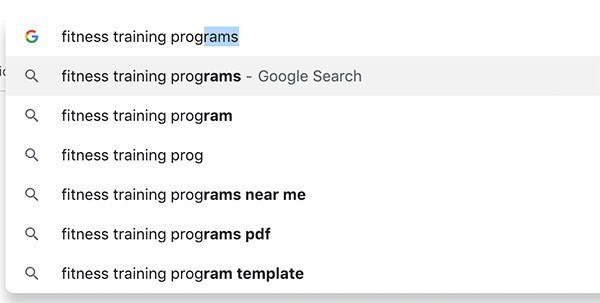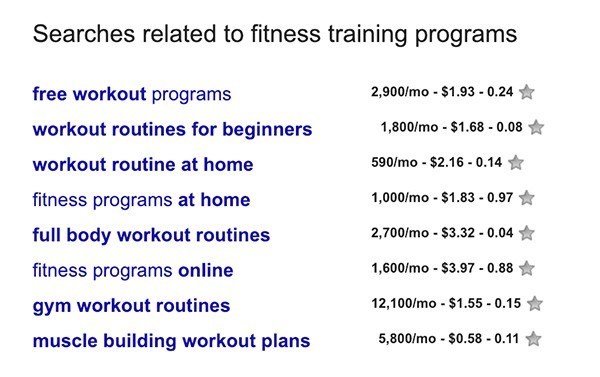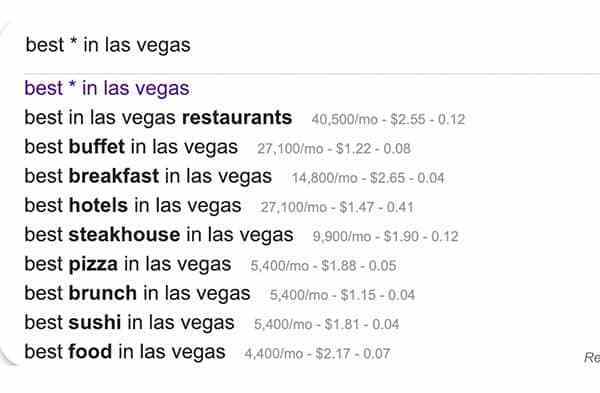I talk about keyword research tips a lot. It might actually get on your nerves. We’re writers — what does keyword research have to do with the ~art~ of writing?
Everything.
Most of us who write blogs want people to actually, you know, read them. You know how you get people to your blogs?
Keywords.
Keywords are what help you rank in Google. They’re what help people find you and click on your page. So, keyword research is 100% part of your job as a writer.
Whether you blog as a hobby or you’re trying to make a living as a freelance writer, you need to know how to conduct at least basic keyword research. This is what’s going to get your writing in front of more eyeballs. That’s always a good thing.
Here are a few keyword research tips for 2020 to get you started.
7 Keyword Research Tips to Help You Get More Traffic in 2020
1. Go for Long Tail Keywords Over Short Tail Keywords
“I want to rank on page one of Google for the word ‘fitness.’” — Client
Good one, Barbara.
Barbara’s asking to rank for what we call a short tail keyword. Short tail keywords are generally one or two words. “Fitness” is an example. So are “shoes,” “lawyer,” and “bakery.”
The reason people want to rank for short tail keywords so badly is that they get massive traffic in Google. For example, here’s “fitness”:

Just an average 1,500,000 searches a month. No big deal. 😐
Understandably, everyone wants a piece of that pie. Why wouldn’t they? They see this kind of traffic and think it means they stand to gain 1,500,000 website hits if they use that keyword.
Wouldn’t we all love that? I certainly would.
There are a few problems here.
#1 Short Tail Keywords Are Typically Far Too Competitive
Because these words are so incredibly competitive, it would take significant (significant!) time and money to rank on page one of Google — if it ever happened at all… which it probably wouldn’t.
Sorry to burst your bubble.
If you ever think it’s truly possible to rank for a massive keyword like “shoes,” do something for me: Google it. Then you’ll see who you’re up against on page one of the search results —Zappos, Macy’s, DSW. Unless you’re a comparable brand in size, popularity, and profit, you’re never going to come close to page one.
#2 Short Tail Keywords Won’t Bring You Targeted Traffic Anyway
Let’s say you’re Barbara, and you have a fitness training site. You create workout programs for people that they can do at home. Cool beans.
Now, let’s imagine someone searches “fitness” in Google. What are they looking for?
They could be looking for fitness training programs.
Or maybe they’re looking for gyms.
Could they be looking for personal trainers?
We have no clue what they’re looking for, because their search query (meaning “fitness”) was so. damn. broad.
What are the odds that this person was looking for exactly what Barbara offers? Slim to none.
We don’t care about people looking for any old fitness-related topic. We want people looking for fitness training programs. That’s our target audience.
Let’s say that best case scenario (and this isn’t going to happen anyway, but I’m playing devil’s advocate), you do get tons of traffic thanks to that broad keyword. So many of those people would click to your site, see it’s not what they were looking for when they searched “fitness,” and they’re going to immediately leave.
Your bounce rate is going to skyrocket, and you’re going to piss Google off. Any way you cut it, it’s not going to work.
That brings us to long tail keywords.
How Long Tail Keywords Can Bring You Qualified Traffic
Long tail keywords are typically three or more words. For example, “fitness training programs” is a long tail keyword.
You’ll notice that because it’s longer, it’s also way more specific than “fitness.” As a result, it gets less search traffic in Google.

See that? A measly 2,400 searches per month, compared to 1,500,000 for “fitness.”
Barbara would see “fitness training programs” and think it was a total snooze fest. Why limit ourselves to a mere 2,400 searches a month when we could get over a million?
Everyone thinks bigger is better — but that’s not always the case, especially when it comes to keywords. Yes, the search volume for a word like “fitness” might be bigger, but your conversion rate for it — meaning how many people actually click through to your website — is going to be next to nothing. This is bad. Again, Google won’t be happy.
What’s so great about long tail keywords like “fitness training programs” is that they’re much more targeted. If someone is searching this in Google, then we know they’re interested in what Barbara is selling.
This means we’re going to convert more traffic into clicks.
Imagine it like this (and this is purely for the sake of having an example): Using the keyword “fitness,” 5,000 people might see you in Google search results, but only two click people click on the link to go to your site.
2/5,000 is 0.04%.
Now imagine you used the keyword “fitness training programs.” Only 1,000 people saw you in search results, but 10 of them click to go on your website.
10/1,000 is 1%.
You see where I’m going with this. The long tail keyword doesn’t get you as much traffic as the short tail keyword, but because it’s more specific and targeted, it send more traffic to your website. Your conversion rate is higher.
As a result, you have a far better chance of ranking for long tail keywords. Hooray! If you can get on page one of search results for a keyword like this, your traffic is going to see a nice boost. Page one is where it’s at.
That ain’t gonna happen with short tail keywords.
This is why you should be prioritizing long tail keywords over short tail keywords. 👍🏻
2. Look at the Related Keywords Google Suggests
Google’s a smart cookie. It knows what you’re thinking before you’ve even though of it. In fact, it delivers to you keyword selections related to the one you’re using.
Brilliant.
You’ll find these suggestions in two places.
First, start typing something into Google. For the sake of consistency, let’s keep rolling with my “fitness training programs” example.
If I start typing this in Google, here’s what happens:

You see how it auto-populates with search terms that start out the same? These are phrases people are actually searching. Therefore, we know it’s stuff they care about.
If you guessed this means that you might want to incorporate some of these into your blog when it makes sense, you are correct, my friend.
The second place you can find related searches is at the bottom of the first page of Google search results.
When I type in “fitness training programs,” hit enter, and scroll to the bottom of the page, I see this:

It’s just so beautiful.
Google takes so much of the guesswork out of this for you. Will all of the keyword suggestions make sense? Of course not. But you’ll certainly get some new ideas from them.
BTW, those numbers to the right? They’re from one of my Google Chrome extensions: Keywords Everywhere. This brings us to our next tip.
3. Use Keywords Everywhere to Determine the Monthly Search Volume and Competition
You’ve probably heard me talk about Keywords Everywhere before, and it’s so good that I’m going to talk about it again.
This is one of my all-time favorite keyword research tips. Keywords Everywhere is a Google Chrome extension (they have it for Firefox too) that tells you the average monthly search volume, cost per click (CPC), and competition of a keyword.
This is my go-to tool — the first place I check when I start doing keyword research before writing a blog.
Knowing how many monthly searches a word gets is obviously helpful. If you try a search term and see it has zero or 10 monthly searches, you should probably keep looking. That term won’t send traffic to your blog.
If you’re seeing an average monthly search volume of hundreds or thousands, now we’re talking.
The CPC doesn’t apply to us directly since it has to do with paid advertising (those ads you see at the top of Google search results), but it’s still cool to see how much people are willing to pay for that word.
The higher that amount is, the more in-demand the word is. People are willing to fork over some serious cash for it.
The competition is also a reflection of paid Google ads. It indicates how many people are advertising that word. Competition ranges from zero to one — zero meaning not many people are paying money for that word, and one meaning a lot of people are.
Even though we’re not dealing with paid ads, I’m sure you can see why it’s beneficial to know how competitive a keyword is, along with the CPC.
Here’s how you can use these three metrics of Keywords Everywhere together.
You’re typically going to want to aim for keywords that are high-traffic but low-competition.
Best case scenario, you unearth a keyword that a lot of people are searching, but not many people are creating content around it, so the competition is relatively low.
Higher competition is an indication that that specific search term might not be your best bet. Yes, it might be getting great traffic. But if too many people people are fighting over it, your chances of being found for that keyword are pretty slim.
I’m obsessed with this extension, and it’s seriously the perfect tool if you’re new to blogging and/or keyword research because it’s incredibly user-friendly. At the same time, the information is so valuable.
You can learn more about my love affair with Keywords Everywhere in this video.
4. Use Google Wildcards for Even More Keyword Suggestions
Want to learn a little trick that’s going to blow your mind?
In a previous tip, you saw that Google gives you suggestions based on the end of whatever phrase you’re searching. So for instance, if you type “fitness training prog,” Google gives you suggestions that complete that — like “fitness training program template.”
What if you want Google to complete a word that’s in the middle of your search phrase?
It can do that too!
It’s called Google wildcards, and all you do is replace the word with an asterisk, like so:

See how Google comes up with suggestions to replace the asterisk?
This is one more way you can come up with new keyword ideas (and blog topics!).
Don’t forget that while you’re using all these keyword research tips, Keywords Everywhere is hard at work. It even works on YouTube — which Google controls — making it even more awesome for people who actively post video content.
The good news never stops.
5. Research LSI Keywords
Latent semantic indexing (LSI) keywords are words that are often found together when talking about a single topic.
For instance, if we’re talking about the keyword “gardening,” a few LSI keywords might be “planting,” “landscaping,” and “vegetable garden.”
The reason we care about these words is that they serve as even more clues for Google, telling the search engine what the topic of your blog is.
To be very clear, there isn’t any proof (at this point) that LSI keywords have a direct impact on your SEO and rankings. However, it does force you to consider related words people might be searching, which could potentially lead them to your content.
LSI keywords might also help you discover new keywords and topics that you can focus future content.
As always, you shouldn’t cram these words into your blog. Only use them if it sounds natural.
On that note, I want to mention one thing…
Above all else, Google values the quality of your work — not the quantity of your keywords.
More than anything, you want the reader to have a positive experience. I promise you aren’t going to “trick” Google by cramming your keyword into your blog 500 times, also known as keyword stuffing.
People used to be able to get away with keyword stuffing. Sadly, to this day, there are still people who think that it’ll work to their advantage. It won’t. Not only will it not work to your advantage, but it’ll also hurt your website, and it also hurts your readers’ experience. Just don’t do it. Google will indeed penalize you for it.
Quality over quantity.
Always remember that before anything else, Google values customer experience. They want the reader to find amazing results when they look for something on the search engine. Readers aren’t counting how many times you use the keyword in your blog. They want to read a good piece of content, plain and simple.
6. Compare Numerous Related Searches in One Chart
Six on our list of keyword research tips is yet another handy research aid. Ever heard of Answer the Public ? It’s basically the most amazing tool ever, right next to Keywords Everywhere, of course.
When you search a topic in Answer the Public, it’ll pull the data of all related searches. In this example, I typed in “fitness training.” Here’s what AtP returns.

When you hover over one of those search terms, all the info from Keywords Everywhere shows up.
Similar to Google’s related searches — which is actually what fuels the information in AtP — these results tell you what’s important to your target audience.
Plus, it’s a much better way of getting a ton of information in one place. You can use either the visualization view (which is the charts) or the data view, which will show you the “guts,” in plain letters and numbers.
Tools like Answer the Public are so important because you may think you know what your audience wants, but until you see the numbers in black and white, you can’t be certain. And it never fails: At some point, the results will surprise you.
Don’t make assumptions. See what the data tells you about what people are searching.
7. Use BuzzSumo to See What Kind of Content People Already Love
Tired of trying to guess what topics people will care about? Thanks to BuzzSumo , you don’t have to.
When you search a topic on BuzzSumo, it’ll tell you how content related to that topic is performing across each social media channel. As an example, I searched “keto,” and this is what it’s showing me:

Pretty neat, eh?
Whether or not you already have a keyword, even if you have just a vague topic you’re curious about, you can search it in this tool and see (a) if people are already sharing content around it, and (b) if readers care. And because it also shows the date, you can determine if it’s something people are obsessed with right now, or if it’s old news.
BuzzSumo is a fast and easy way to figure out what people want to read about. Brilliant.
So there you have it — seven keyword research tips that have made a huge difference in my blogging, and I’m confident they’ll do the same for you.
Get More Help Learning How to Do Keyword Research
Getting people to visit your blog is hard — I know. I used to spend hours writing what I felt were incredible pieces of content, only to hit publish and wait for the page views to start rolling in… and they never did.
Now that I know how to use keywords to my advantage, I want to teach you how to do the same. If you enjoyed these keyword research tips, you’re going to want to grab this freebie.
I created a guide that will take you through my step-by-step process for finding keywords.
You can get the guide for free here.
(And yes, it’s 100% free.)
This process has helped me take clients’ blogs from zero to 1,000+ hits in just a few months. It really works. Check it out.
Which of these keyword research tips did you find most helpful? Join my private Facebook group and leave a comment about it!